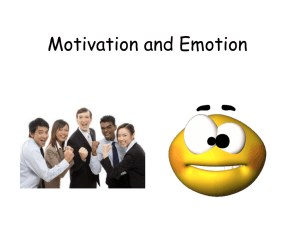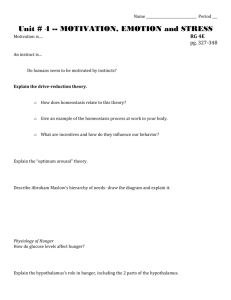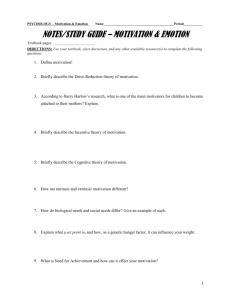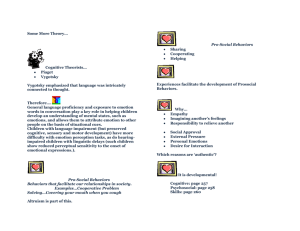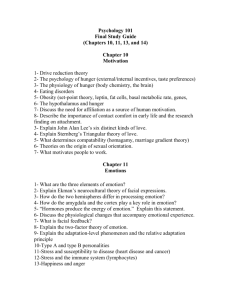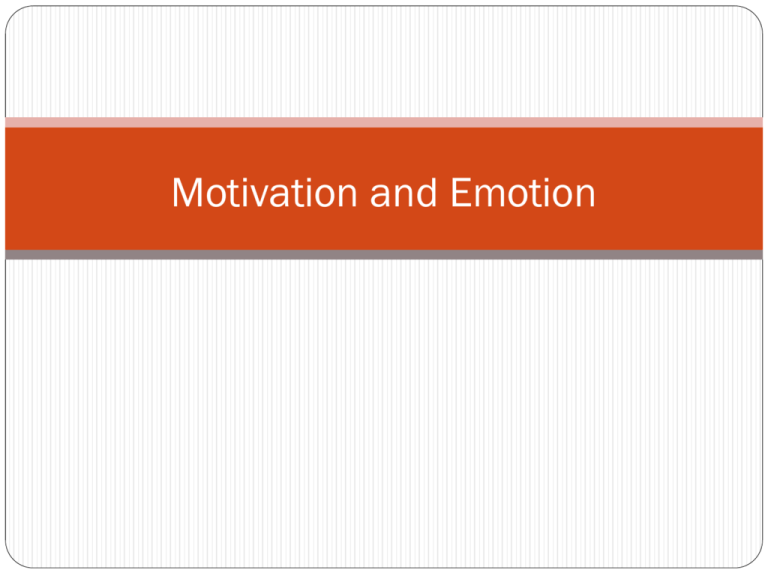
Motivation and Emotion
Motivation – why people do the things they do.
Feelings or ideas that cause us to act towards a
goal
Theories of Motivation
1.) Instinct Theory: (evolutionary perspective) – automatic
behaviors in response to specific stimuli
2.) Drive Reduction Theory: behavior is motivated by biological
needs
Needs: required for survival
Drives: impulse to act in a way that satisfies a need
Body seeks homeostasis – a balanced state where our needs are being
met
Ex: I skip breakfast and by 10:00 am I am starving (need). I have a
drive to borrow money from a friend and sneak out of class to get a
snack from the vending machine to return my body to homeostasis
Theories of Motivation
3.) Arousal Theory – when people seek an optimal level of
excitement or arousal. People with high arousal levels are
drawn to risky/exciting behaviors – sky diving, mountain
climbing, explorers, etc.
4.) Incentive Theory – we do behaviors to attain a reward – end
of year bonus, more money for a higher degree, etc.)
5.) Maslow’s: hierarchy of needs – not all needs are equal.
Needs are prioritized and ones on bottom must be met first.
Maslow’s Hierarchy of needs. Ultimate goal = self
actualization – reaching one’s ultimate potential.
Hunger and Eating Motivation
Hypothalamus
Hypothalamus is biologically involved in regulating our hunger. It
helps monitor the body chemistry (ration of glucose and insulin –
hormone secreted by the pancreas) and makes us feel hungry
when we need to eat and satiated when we don’t need to eat
Opposing parts
Lateral Hypothalamus – send signal to eat
Ventromedial Hypothalamus – sends single of satiety
When this works correctly the hypothalamus helps us to maintain our
ideal set point – body’s perfect weight based on our gender, build,
and metabolic rate.
Psychologically we can over-ride the hypothalamus when we want to
which is why most people are not at their set point.
Psychology of hunger
Often we eat or want to eat for reasons that have nothing to
do with biology
Internal eaters – less affected by the presence of food, the
clock, or their emotions. They are more likely to eat when they
are truly biologically hungry. i.e. “no thanks for the doughnut. I
just ate breakfast and am not hungry”
External eaters – eat based on external food cues. It’s time to
eat, that food looks good, I am sad and want some ice cream,
etc. “Man that doughnut looks good even thought I just ate
breakfast. How can you pass up a doughnut?”
Psychology of hunger
Garcia Effect – learned taste aversions (classical
conditioning) will make us not want certain foods even if we
are hungry. To this day I don’t like Kraft macaroni and
cheese!
Culture - we typically prefer foods that are most familiar to
us (connected to mere exposure effect)
Eating Disorders - BULIMIA
Binge – consuming a large amount of calories in short period of
time (usually less than 2 hours).
Purge – self induced vomiting, laxatives, excessive exercise
2X a week for 3 months
More commonly women
Usually obsessed with food, weight, and body image
Easy to hide – most bulimics maintain a normal weight
Problems – electrolyte imbalance, dental problems, tears in
esophagus, dehydration, abrasions on knuckles, often co-exists with
anxiety or depression
Bulimia
Eating Disorders - ANOREXIA
Diagnostic Criteria
1.) 85% or less of ideal body weight (i.e. really thin)
2.) restricting – intentionally not eating
3.) skewed body image
More likely in women, teenage girls
Often perfectionist, over-achieving personality (type A,
obsessive, intensely concerned about how others perceive them)
More common among Caucasians
Weight restricting sports especially at risk – dance, ice skating,
gymnastics, etc.
Stop menstruation
Anorexia…inside the body
Brittle bones
Hair falls out
Muscles atrophy
Brain atrophy
Blood pressure drops
Heart slows
Cold
Anorexia is lethal – it has the
highest mortality rate of any mental
illness, including depression (10%)
Culture and Anorexia and Bulimia
Eating disorders affected by media driven culture (especially
in the Western world) that focuses on perfect, thin, ideal –
i.e. Barbie
Women more likely than men to have negative body image
½ women report having a negative body image
Models and “ideal” body has gotten thinner and thinner over the
years
Even girls at a very young age (pre-teen) diet and are aware of
weight
Eating Disorders - OBESITY
Severely overweight (often in excess of 100 extra lbs.), BMI
30+, and excess weight affects health
CDC says 66% of adults in American are overweight and
27% are obese. These numbers have been on the rise.
The top 4 killers in American are related to weight – heart
attack, stroke, type II diabetes, and cancer
WHY? – fast food, portion size, sedentary, genetic
predisposition, etc.
BMI Chart
Sexual Motivation
Sexual motivation is vital for the continuation of any species.
Reproduction is the primary task of most living organisms. Like
hunger, sex is motivated by both biological and psychological factors.
Sexual Response Cycle
4 stages
1.) excitement – genitals
engorge with blood, increase
heart rate
2.) plateau – heart rate and
breathing continue to
increase
3.) orgasm – genital
contractions, ejaculation
4.) resolution/refractory
period – body returns to un aroused, normal state.
Stages are same for both
genders.
Sexual motivation
Male hormone - testosterone
Female hormone – estrogen
Psychological factors affect sexual motivation (i.e. attraction
varies)
Sexual attitudes and behaviors often vary significantly across time
and cultures.
Sexual orientation – cultures across time have been predominantly
heterosexual yet homosexuality seems to have been an ever
present minority in all cultures
APA drops homosexuality as mental illness in 1973
Gay marriage – big issue in political scene today
See text p. 471-477 – nature/nurture evidence
Social Motivation
What motivates behaviors more complicated than sex and eating?
Your attitude, society, family, friends, culture, etc. will also affect
what you are or aren’t motivated to do.
Social Motivation
1.) Humans have an innate need to belong, be accepted, and
maintain social relationships (think of Maslow, Harlow)
2.) Achievement Motivation – desire for significant
accomplishment, mastery of skill, attainment of high
standard
AM varies from person to person and from activity to activity (I am
highly motivated to achieve in sports, not at all in music)
People with high AM prefer difficult but attainable tasks – they don’t like
things that are too easy or that are impossible to achieve
People with high AM are more persistent and less likely to give up on
their goals. They hate losing or failing.
Social Motivation
Intrinsic
Extrinsic
You do things for yourself
You do things for external
– you enjoy it, it is
rewarding
You would do it if no one
was watching or there
were no reward
Ex: Johnny does his HW
because he finds the
content interesting
reasons – outside rewards
Recognition, money,
promotion, expectations
Ex: Johnny does his HW only
because he wants to get an A
and get money from his parents
for a good report card
Social Motivation
Extrinsic V. Intrinsic
Over justification effect: when
external rewards, external
pressures, extrinsic motivations
ruin the pure enjoyment of an
activity. Ex: I originally played
tennis because I loved it and it
was fun. As I got better the
pressure to win, rankings, etc.
ruined the enjoyment.
Over time, intrinsic motivations
are more effective, especially
over time.
Social Motivation –
Management Styles
Theory Y Manager
Theory X Manager
Believe their employees are
Believe their employees are
intrinsically motivated
Hands off style
They believe their
employees love what they
do and want to be at work.
So these managers stay out
of the way and let their
employees do their thing
extrinsically motivated
They micromanage
Set up rewards for good
behaviors
Set up punishments for bad
behaviors
Employees will not work
hard unless managed to do so
EMOTION
Emotion and Motivation are closely intertwined
Theories of Emotion
James - Lange: physiological response precedes emotion. I see a
spider, my heart races, therefore I feel fear.
Cannon – Bard: physiological response and feeling of emotion
happen simultaneously. I see a spider and at the same moment in
time my heart races and I feel fear.
Stanley Schachter Two Factor: physiological response and a
cognitive label happen simultaneously and precede the feeling of
emotion. I see a spider, my heart races and my brain labels it as
fear at the same time, and then I feel the emotion of fear.
(Says you must have cognitive label because different emotions
have similar physiological reactions. My heart pounds when I am
excited and when I am afraid, so the brain must label it).
Theories of Emotion
Opponent Process Theory of Emotion – the idea that often
the emotion that precedes an event is the opposite of the one
that comes after it. Ex: I am anxious and dreading an
upcoming test. When it’s over I feel extreme relief and
peace.
Catharsis: positive release of negative energy. “Venting”
I come home from school really angry and I write a poem
and my anger and afterwards feel a lot better
Culture and Emotion
Emotions and facial
expressions seems to be
universal across cultures
However, hand gestures
vary from culture to
culture
i.e. don’t go abroad and
give the a-ok sign!
Emotion - STRESS
Stress is a powerful and can be a dangerous emotion. Chronic
stress can result in physical, mental, and emotional break down
Lack of perceived control over a problem exacerbates feeling of
stress
Stress caused by 1) catastrophies (9/11), 2) significant life change,
3) daily hassles
SRRS = Social Readjustment Rating Scale
Measures stress by using life changing units
Major life changes increase stress score
Even positive changes (wedding, new job, baby) can cause significant
stress
Stress – Hans Selye
General Adaptation Syndrome
The body has a general adaptive
response to stress
1.) Alarm reaction – heart rate
zooms, sympathetic NS kicks in
2.) Resistance – body stays on
high alert. Hormones released
to maintain ready state.
Temperature, blood pressure,
and breathing remain high
3.) Exhaustion – body’s
resources start to be depleted,
immune system breaks down.
Vulnerable
Stress
Chronic stress can cause or exacerbate several health conditions
Heart disease
Mental illness
Insomnia
Depression/anxiety
Compromises immune system (+ corr between stress and colds)
Higher blood pressure
Headaches
How to manage stress….?
Exercise, sleep, friends/social networks, meditation, hobbies, take control of
the situation
Stress: Type A Versus Type B
Type A – people that have a
competitive, driven,
impatient, high achieving,
often high stress
personality
Type B – people who tend
to be more easy going,
relaxed, and experience
less stress/anxiety
HAPPINESS
What variables correlate with happiness??
Spirituality/religious involvement
Sleep
Exercise
Good relationships
Service/investment in others
Gratitude/spirit of optimism
Satisfying work and leisure that engages your skills
Wealth – up to a point (not having enough to meet basic needs =
unhappiness, but once you have sufficient, more money does not
mean more happiness
Age, gender, and attractiveness do NOT correlate with happiness
Denmark has the highest rates of self-reported happiness
Final terms
Feel good Do good Phenomenon: We are more likely to help
someone when we feel good and are in a good mood and in turn
when we help someone we feel good about ourselves.
Relative Deprivation Theory: Our own happiness is relative to
who we are comparing ourselves to. If I compare myself to people
who are wealthier, more attractive, etc I feel sad. If I help people
who are less fortunate than me, I am grateful for what I have and
feel more content.
Adaptation Level Theory: we adapt and adjust to new
circumstances and return to our base level of happiness. I get a
big raise at work - it makes me happy temporarily – I adjust and
in a few months and complaining about my salary again.
Polygraph - lie detectors
Measure physiological responses that accompany emotion –
changes in breathing, pulse rate, blood pressure, perspiration
Assumption – when we lie, we become agitated and physically
aroused
Problem – savvy criminals can maintain calm while lying and beat
the lie detector (20% of time lie detector says innocent when
person is guilty)
Problem – innocent people are nervous and anxious and they body
also becomes aroused and they fail (30% of time polygraph says
guilty when really innocent)
Collectively polygraphs are wrong about 25% of the time.
Inadmissible in a court of law.

